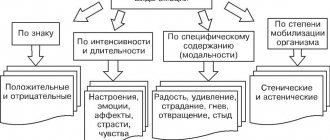Hello, dear readers! Only a harmonious personality can be successful and happy at the same time, do you agree? And an important aspect of such a personality is normal self-esteem. Not inflated to the skies, when a person imagines himself to be a genius without reason. And not low, from which it is impossible to move forward.
Problems with self-esteem are often an unstable psyche, anxiety, disappointed expectations or inadequate goals. And many unnecessary difficulties in life!
Do you want to develop harmoniously as a person, set adequate goals for yourself and achieve them?
Then you just need to determine the level of your self-esteem. You can do this right now using the Dembo Rubinstein self-esteem test. This is exactly what we offer you in this article. Important advantages of the method are the possibility of independent research, detailed explanations, and detailed instructions for the test.
A few words about the creators of the test
In fact, this Dembo-Rubinstein test is a psychodiagnostic method. It is used for a detailed study of a person’s self-esteem and self-perception. The developer of this technique was Tamara Vulfovna Dembo, a well-known psychologist in the USA, doctor of Clark University and student of Kurt Lewin. T.V. Dembo created this test in 1962.
8 years later, in 1970, it was modified by Susanna Yakovlevna Rubinstein, a famous Soviet psychologist, employee of the pathopsychology laboratory of the Moscow Research Institute of Psychiatry. Interpretation options have been added to the test.
The Dembo-Rubinstein method has been actively used by psychologists and psychotherapists for more than 40 years. With its help, you can diagnose the stability of your attitude towards yourself, the background of your mood, adequacy, maturity, the presence of problems, the level of criticality and demandingness. And also, in general, the level of satisfaction with one’s personality.
Types of self-esteem
In psychology, depending on how correctly a person evaluates himself, two main types of self-esteem can be distinguished: adequate, inadequate .
A person’s opinion about himself is considered adequate if it coincides with reality. Otherwise, when self-esteem sharply differs from the opinions of others, it is inadequate. In this case, self-esteem can be overestimated or underestimated.
With an underestimated assessment, self-doubt develops, which manifests itself in all human activities.
The opposite is inflated self-esteem. In this case, a person considers himself ideal or close to it.
Another criterion is stability of self-esteem . It can be stable or influenced by external factors (floating). In the first case, a person’s opinion about himself remains unchanged in any situation. With a floating assessment of oneself, it changes depending on successes and defeats, on the opinions of others, namely on approval or condemnation.
Life story
My cousin is an engineer by profession. But at heart he is a real psychologist! She loves all kinds of psychological tests. He enjoys testing himself and all his family and friends. She had been looking for a long time for a suitable test that would help determine the level of assessment of herself and her personality.
The various tests seemed too complicated and confusing to her. But my sister was completely satisfied with the Dembo Rubinstein test! With its help, she successfully tested not only her family, but also her colleagues.
Many of them, including managers, began to think seriously after receiving the results. I am confident that this analysis helped them embark on the path of personal development and self-improvement.
Additional techniques for the Dembo-Rubinstein technique
An additional technique includes analyzing people's behavior during testing.
Signs of unstable self-esteem:
- many crossings out (changing a line to a lower one and vice versa);
- Job execution is too slow.
Signs indicating an inflated opinion of yourself:
- the desire to attract the attention of others while performing a task;
- completing it too quickly (a person is afraid to think and truly evaluate his level, admit failure in some areas).
Another additional way is an individual conversation after testing. The person is asked to explain which people he considers happy and to name the reasons for his own failures. All other scales are discussed in the same way.
How to complete this study yourself?
Everything is quite simple. To take the Dembo Rubinstein self-esteem test, take a piece of paper (or a form) and draw four lines vertically. The height of each is clearly 100 mm. Lightly mark the middle of each scale. One point is 1 mm. A checkered sheet is ideal for this.
They will indicate indicators of health, intelligence development (smart), happiness and character. You can also add optimism and general satisfaction with yourself. for teenagers : health, character, intelligence, abilities, beauty, authority among peers, self-confidence (see picture from the Dembo Rubinstein test).
The top of the line is the state of the maximum limit of the indicator (for example, happy, smart, beautiful), the bottom is the minimum value (unhappy, stupid, ugly). . Think and put dashes on the lines where your current state is.
Dembo Rubinstein self-assessment test, student form:
Now, after reflection, draw circles (“o”) where you would like (dream) to be. And finally, the crosses are where you can still be objective if you put in the effort.
If you take a ruler, measure the distances in mm. and write them down. You have received a table where the level of your aspirations is a segment from the very bottom of the scale (zero value) to the crosses. The level of self-esteem is the interval from the bottom of the scale to the dash (-). The discrepancy is the line between the level of your aspirations (cross) and your assessment of yourself (dash).
Dembo-Rubinstein test: instructions and task
The technique is easy to use. It is necessary to draw four vertical lines on a sheet of paper. Line names: “Health”, “Mental abilities”, “Character”, “Happiness”. Additional scales can be added to this list: “Optimistic qualities”, “Degree of self-satisfaction”, etc.
Parameters of each scale:
- height – 100 millimeters;
- 1 point is equal to 1 millimeter of line;
- there is a dot in the middle of each scale;
- at the ends of each scale there are horizontal lines (the upper line is the highest score for the parameter under study, the bottom line is the lowest).
The test taker needs to:
- Use a horizontal line “–” to mark your current level.
- The circle “o” is the place where he would like to be between these two lines (state of satisfaction).
- The cross “x” is the place where he may end up if he really evaluates his own capabilities.
Important information! The test runs before the results are read. Failure to comply with the condition increases the risk of erroneous decryption.
12 minutes is the maximum time to complete the test.
Results and recommendations
Processing the results here will not take much time. The results of the test, based on the level of self-esteem, can be analyzed separately for each specific scale. Or as the arithmetic average of all indicators.
For example, if four scales were used for the study, then the total amount of points should be divided by four, if there are six scales, then the total amount should be divided by six, etc.
The health scale, as a rule, is not assessed; it is a testing scale.
Using it, the psychologist determines how correctly the test subject understood the principle of the test. But when checking myself, I found it necessary to analyze the health scale.
Keys for self-esteem level (dash)
- an increased level of assessment of a specific personality ranging from 50 points to 75, this indicator is realistic and adequate;
- your scores - from 75 to 100 - this is an overestimated indicator, it indicates moderate, but deviations in personality, slightly inflated claims, insensitivity to your mistakes;
- points up to 50 - very low self-esteem, along with it - problems with self-perception, confidence, perhaps you need specialist help and correction.
Keys to claims (crosses):
- final scores from 60 to 90 – aspirations at a realistic, achievable level;
- points from 90 to 100 – lack of criticality, inflated expectations and claims;
- points up to 60 – too low aspirations, possibly problems with personality development and self-confidence.
How to evaluate results
As mentioned above, the Dembo-Rubinstein test helps to determine the level of self-esteem. Its main properties are height, stability, and realism.
Self-esteem level values
Interpretation of the results of the Dembo-Rubinstein self-esteem diagnostic technique looks like this:
- 50-75 points - average and high self-esteem. A person evaluates himself adequately and looks at things realistically.
- 75-100 points – inflated self-esteem. Perhaps some disturbances occurred in the process of personality formation. A person perceives himself distorted, he does not want to learn something new, does not notice his mistakes, and is insensitive to criticism and comments.
- Less than 50 points – low self-esteem.
After evaluating the results, you need to find out why the person treats himself this way. For what reasons does he doubt his capabilities or, conversely, exaggerate himself excessively?
Keys by claims
There are also several options for evaluating the results:
- 60-90 points is the real level of aspirations.
- 90-100 – unrealistic view of oneself, lack of self-criticism.
- A score of less than 60 points means too low aspirations. Evidence of improper development of character and personal qualities.
In the traditional modification of the Dembo-Rubinstein technique, a person with adequate self-esteem will place a mark (horizontal stripe) slightly above the middle of the line. The ideal (zero) for him would be the option below the top of the scale. The best place to place the cross is in the middle of self-esteem and desires.
If current self-esteem is marked below the middle of the scale, a person suffers from excessive self-criticism and demands too much from himself.
The relationship between self-esteem parameters
The relationship between all the icons on the scale looks like this:
- The correct location for X is between 0 and "-".
- The distance between X and 0 is what you want but can't achieve yet.
- X is what is available to you. Anything above this mark is unattainable.
- The line down from X to your current self-esteem is what you will achieve with a little effort.
- The ratio between the segments before and after X is your level of optimism.
0 must be below the upper limit of the scale. If it is located at the very top, one can judge the person’s immaturity. A mature personality understands that it will never be possible to become perfect.
If the indicators on the vertical lines are too far from each other, the subjects are emotionally unstable. According to psychologists, 0 is a person’s dreams. Almost all people have dreams. And when they manage to fulfill one dream, they take on another. It turns out that they set and achieve goals.
X – real prospects, the level of your goal. In the process of moving forward, one goal is replaced by another. 0 must remain above X. Otherwise, inflation of the dream or its depreciation will occur.
conclusions
Using the "Ladder" it is possible
- determine self-esteem and level of life adaptation of children;
- prevent the occurrence of problems, correct deviations of self-esteem from the norm;
- teach students to interact with each other while completing a common task;
- create teams where children independently choose a role and test each other;
- teach children to positively evaluate the results of their activities.
Self-esteem is an important indicator of personality. Children of primary school age form an idea of themselves and determine their place among others. Using self-esteem diagnostic methods, an adult can promptly detect problems in a child’s sense of self. The research results help correct the student’s behavior, teach them to adequately assess their own capabilities, discover new abilities, and develop the process of self-knowledge.
When does it start to form?
Self-esteem cannot be formed without the presence of another personal property - self-awareness. It occurs in childhood, up to approximately 3 years of age, when the child realizes his autonomy from his mother, identifies himself with a certain gender and begins to express himself as an individual (the so-called “seven-star crisis” of this age). As a child grows up, he has the opportunity to evaluate himself at an elementary level and analyze the attitude of others towards him. At this age, we can talk about the beginnings of self-esteem, since it is formed over a long period of time and remains dynamic throughout life.
What it is?
to evaluate yourself correctly .
Some people feel mature and smart, while others are always dissatisfied with themselves, therefore they feel insecure and filled with a huge number of complexes.
To give an objective description of oneself, the technique of Tamara Dembo, a native of Russia who emigrated to Germany, was developed.
It was supplemented by our compatriot, Soviet psychologist Susanna Rubinstein.
The technique is simple – the test taker is offered 4 drawn scales that meet the following criteria:
- mind,
- health,
- happiness,
- character.
Each scale is 100 mm, where each millimeter is a certain point . There is a dot in the middle of each line. A person marks on these vertical lines with different icons (dash, circle, cross):
- What is he like today?
- What would you ideally like to be?
- What will be the satisfactory level for yourself if you start analyzing and working on yourself?
Then, according to the designated signs (dash, circle and cross), a characteristic of each person’s self-esteem is given, depending on where the person placed this or that sign.
The diagram will show how different “the real me” is from the “ideal me”.
All marks below the average level indicate low criteria for a particular indicator, above indicate high and inflated ones.
You will find a list of the most common phobias on our website.
Instructions for conducting the study
A person can understand what needs to be done in a test by reading the instructions. It says that everyone has the opportunity to evaluate their abilities, character traits, capabilities, and so on. Your assessment can be expressed on a segment, at one end of which the low points begin, and at the other end - the maximum 10 points. It is necessary to mark on each scale with a dash “-” the level at which the development of this quality or property is now. Then you need to mark on these scales with a cross “x” the level at which the person being tested can feel self-satisfaction or pride.









